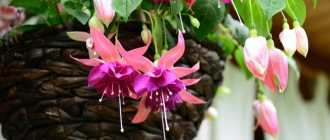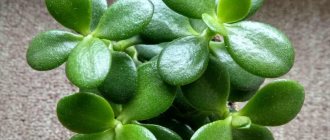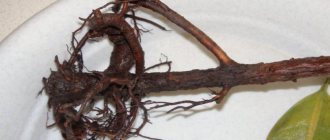Causes of the disease and their elimination
Errors in care
The most common problem is due to improper care. Like all cacti, the Decembrist is calm about dry soil or rare fertilizing. According to experts, the rule applies to zygocactus: it is better to under-supply than to transfer. To preserve the decorative quality of Schlumbergera, you need to know the causes of the problem.
Dry leaves are caused by excessive sunlight, too dry air and stressful situations. To avoid drying out of the leaf plates, it is better to place the flower on the windowsills of western or southwestern windows. If it is impossible to place the pot with the plant away from the bright sun, the epiphyte must be shaded.
If the Christmas tree has soft leaves or drops them, it means the plant has problems with the root system or is infected with parasites.
Too wet soil and excessively low or high air temperatures cause rotting of Schlumbergera roots and the development of putrefactive processes in the pot. This happens due to overwatering and when the pot overheats, when the roots melt and burn. Most often, overheating of the pot occurs because the flower is standing in the sun or directly above the central heating radiator. In overheated soil, fermentation processes easily occur, leading to the death of the flower. also leads to burning of roots .
Damage to the root system can be determined by observing the plant: if the flower is unstable or comes out of the soil, then the roots of the cactus have rotted. You can revive the Christmas tree:
- rooting living healthy segments to produce new seedlings;
- transplanting the diseased flower into another container, removing the dead part of the roots.
Fungal diseases
Another reason is hidden in fungal diseases. If the zygocactus has withered, turned pale and is rotting at the root, it means the plant is infected. Most often, the Decembrist falls ill:
- late blight;
- pythium (a type of root rot);
- fusarium.
Basically, plant infection occurs through infected soil. Some diseases develop very quickly. So, pythium can destroy a flower within a few hours. The disease begins with damage to the roots, then the buds and leaves wither and fall off. As a result, the plant dies. With late blight, the plant trunk turns yellow, starting from the root collar, the leaves become soft and fall off. With fusarium wilt, the leaves of zygocactus are not fleshy, but dry and covered with light green or yellowish spots.
To prevent and combat late blight and pythium diseases, Decembrist is treated with solutions of drugs:
- “Skor” – 0.5 ml per half liter of water;
- “Maxim” – 5 drops per two hundred gram glass of water;
- “Topaz” – 1 ml per 5 liters of water;
- “Vitaros” – 0.5 ml per 0.5 liter of water, twice with a break of 10 days.
When affected by Fusarium, treatment can only help at an early stage of the disease. The flower can be treated with a solution:
- "Fitosporina";
- "Sporbacterin";
- the drug "Mikol" and other antifungal agents.
If the disease is advanced, it is impossible to save the Decembrist. All that remains is to burn the diseased plant, and disinfect the soil and pot.
To prevent infection of the flower, a few days before planting, the soil substrate should be treated with boiling water, and a couple of days before planting, the biological product “Trichodermin” or its analogues should be added to slightly moist soil.
Parasite infestation
It is not only fungus or root rot that leads to the death of the Decembrist. If the leaves dry out and turn yellow, and when examined, yellow-brown spots up to half a centimeter in size are noticeable on them, it means that the flower has a sucking pest - scale insects. Despite its miniature size, this parasite causes significant harm, and if you do not pay attention to the problem in time, the plant will die. The most suitable environment for scale insects to reproduce is very humid air . But the insect does not like high temperatures, which can be used to prevent the development of the affected area.
What to do to help the plant?
In case of overdose of fertilizers
Replanting the plant will help. For this:
- You need to choose a pot suitable for the plant - the Decembrist prefers not too deep pots and blooms in them much more readily.
- Buy special soil for cacti and add drainage to one third of the pot.
- Remove the plant, remove damaged roots and plant in new soil.
- Do not feed for at least a month after transplanting.
In case of root damage
If the process has not gone too far, temporarily canceling watering and maintaining high air humidity will help. Next, adjust the watering regime, bringing it into line with the air temperature - the lower it is, the less moisture is required.
If the roots are almost lost and the plant has suffered greatly, it should be re-rooted
- Pinch off a few leaves, put them in water and plant them in the ground after the roots appear. Usually roots appear in 10-12 days. You can read more about rooting Schlumbergera cuttings here.
- Transplant the old plant into new soil for cacti; when replanting, remove rotten roots and treat the remaining ones with a weak solution of potassium permanganate.
- After transplanting, water very sparingly and only through a tray.
In case of infection
If the infection is not too advanced, the plant should be treated with fungicides. Any of the mass-produced medicinal drugs, such as Fitosporin, Maxim, Skor, Topaz, will do.
Important! The entire plant must be treated, paying special attention to the root collar. If the disease is advanced and the plant is seriously damaged, you must first replant it in new soil and then treat it with the drug. Fresh soil will help the plant recover faster
Fresh soil will help the plant recover faster
If the disease is advanced and the plant is seriously damaged, you must first replant it in new soil and then treat it with the drug. Fresh soil will help the plant recover faster.
When attacked by parasites
Whatever parasites settle on the plant, first of all you need to remove them from the leaves as much as possible
First, wash them off with a warm shower, then carefully wipe the leaves with a cotton pad and a solution of laundry soap.
Treat the dried plant according to the instructions with one of the following insecticides: “Aktellik”, “Fitoverm”, “Neoron”, “Aktara”. Carry out the processing in several stages. The outer surface of the pot and the window sill should also be disinfected to destroy possible pest larvae.
If Schlumbergera is weakened by improper care
It is necessary to create conditions for the Decembrist that are as close as possible to the conditions of the plant’s “native” tropical forest.
Main factors:
- Lack of direct sunlight, diffuse lighting. Place the pot on the western or eastern windowsill or at the back of the room.
Sufficient air humidity. Achieved by regular spraying with soft, warm water, especially during the heating season. In especially severe cases, you should place a container of water next to the pot. Stable air temperature from +20 to +25 degrees. The plant should not be placed on a southern windowsill; drafts should also be avoided. Regular, moderate watering. If for some reason the plant is very dry and the leaves have lost their tone, you need to water it through a tray and spray it generously with warm water. Feed the Christmas tree twice a year with complex fertilizer, halving the recommended dosage.
We are treating the green friend. Why does the Decembrist have limp soft leaves and how to correct the situation?
This plant got its name due to its flowering in December. Imagine: it’s frosty outside, a blizzard, and a Decembrist bloomed on your windowsill. With proper care, it can bloom several times a year. In addition, this flower is very easy to care for. This is another good reason to add Schlumbergera (this is the second name of the plant) to your collection of indoor flowers.
But everything is not so cloudless: the Decembrist can get sick. This article will describe possible problems with Schlumbergera leaves: we will look at why the leaves of this plant fall off or become thin, why the flower withers and sheds its foliage, and we will also suggest ways to treat ailments.
How to protect Decembrist from root rotting
In order not to think about why the Decembrist has limp leaves, photo, you can periodically carry out preventive measures and thereby prevent negative phenomena. Try to adjust the watering schedule. It should be moderate, especially if it is cold in the room where the flower stands. It’s easy to determine whether a plant needs to be watered. Look at the condition of the top ball of soil. If it's dry, you can add water. If the soil is wet, then you should wait until it dries. It is not difficult to do this correctly. But experts do not recommend watering with a certain frequency. After all, the soil dries out at different speeds, depending on the air temperature around it. In such a situation, it is easy to fill the flowerpot as soon as cold weather arrives.
You should also protect the plant from extreme heat. In winter, do not place it close to radiators; in summer, try to take it outside in the shade more often. Fresh air will ventilate the soil, which will prevent it from souring and, consequently, rotting of the roots. Pests do not take root well in soil saturated with air.
Replant the plant on time. Over time, the soil becomes more and more compressed. It begins to let in little air and retains more and more water. Sometimes the roots occupy the entire area of the flowerpot, which is also bad. Fertilizers can no longer fully replenish the required amount of nutrients. If you do not replant such a plant, it will begin to wither and may die. Move a young Decembrist to a new flowerpot once a year, a mature one - once every 4-5 years.
Watch a video about how to care for Decembrist whose leaves are withering, and also read other articles on our website.
Why is the crown sluggish and soft?
Infections
These diseases oppress the base of the root system. This leads to a loss of connection between the above-ground and underground parts of the plant.
It seems to a florist that if he waters and fertilizes a flower, it means it should bloom and develop. But the whole problem is that only the roots are moistened, but the moisture does not reach the above-ground part. All these factors cause not only the withering of the leaves, but also the slow death of the plant as a whole.
Symptoms of infection can include more than just limp leaf blades.
To the signs of an infectious disease, you can also add the falling off of parts of the Decembrist , as well as the blanching of the leaves or even the transformation of their green pigment into grayish.
(But do not confuse the burning of leaves in the bright sun.) Often, late blight and pythium diseases are accompanied by spider mite damage. This process is easily recognized by the rusty pigmentation on the leaf plate. The spots may be accompanied by the death of buds.
How to distinguish it from other ailments?
In order to figure out what exactly caused the leaves to wilt, you need to carefully examine the entire root system of Schlumbergera. When infected, only the tops of the roots rot, and in all other cases we are dealing with rotting of the deep central rhizomes.
Treatment
First of all, it is worth saying that the plant needs to be inspected as often as possible. Then you will be able to notice the infection in the early stages, which will help you cope with ailments without much loss. If the leaf blades have just begun to die due to infection by infectious diseases, then it is necessary to immediately treat them with fungicidal preparations. The most popular of them:
Root system diseases
It happens that no infections were found on the flower, but the leaves still wither for some reason. It could all be a matter of simple root rot. This happens for several reasons:
too frequent and abundant watering;
- too low or, conversely, high indoor air temperatures.
If the Decembrist does not have time to “drink” the water, it begins to stagnate and form a so-called swamp. In cold conditions, the rhizomes begin to rot , and in extreme heat, the roots simply wither or burn. In one case or another, the underground part of the plant ceases to function normally and cannot fully provide for the above-ground part of the flower. This is why the leaf plates decline.
Problems when growing Decembrist
If you follow all the rules for caring for a flower, it grows and blooms well. But problems when growing Decembrist are still not excluded, which means that the most common ones are better studied.
What diseases of the Decembrist exist and what pests threaten it?
The plant can be affected by fungus and some pests.
Decembrist leaves should be inspected periodically.
- Whitish lumps between the shoots are a sign of a flower being infected with a mealybug, which is not so easy to get rid of. The affected plant must be urgently treated with special products that can be bought at flower shops.
- A rusty coating and barely noticeable cobwebs on the leaves are a signal that the Decembrist is attacked by a spider mite, which can appear in conditions of insufficiently humid air. The preparations “Fitoverm”, “Neoron” and “Actellik” will help eliminate the insect and the consequences of its vital activity.
- Most often, the fungus that affects the zygocactus is late blight, fusirium and phytum. First of all, the fungus damages the root collar of the Decembrist, which is why the flower withers in moist soil and turns pale, becomes gray, and loses segments. The therapeutic measure in this case is to treat the plant with the fungicides “Topaz”, “Maxim” and “Vitaros”. It is necessary to control the soil moisture, preventing it from becoming waterlogged. It is necessary that the soil dries out well between waterings.
Decembrist does not bloom - what to do?
You can stimulate Decembrist flowering in the following way. In autumn, you should provide the plant with a period of rest by placing the flower in a cool room. During the “hibernation period,” zygocactus is almost not watered and not fed at all.
At the end of November, the Decembrist plant is placed on a well-lit windowsill and watered. Waking up, the plant begins to bud.
In order for the Decembrist to bloom profusely, it needs to be properly cared for.
keep the zygocactus in a narrow bowl; in winter, illuminate additionally using artificial lighting; during flowering, do not move or turn the bowl, do not prepare cuttings for planting; In no case should the zygocactus be subjected to temperature fluctuations during flowering; maintain flowering by providing the flower with cool air, the temperature of which should not exceed +16C; At the end of the dormant period, water and feed the plant very carefully so that the flower does not get too stressed and drop its buds.
If you decided to buy a Decembrist and brought it home blooming, but soon the flowers began to fall off, do not panic. The plant needs some time to adapt to new living conditions.
Reasons for wilting of zygocactus
As previously mentioned, the Decembrist withers when it is affected by a fungus. Another reason for wilting is root rotting. If the plant trunk begins to sway and the flower becomes unstable, this indicates the death of the roots.
This can be caused by watering the zygocactus with cold water, overheating the bowl in the sun, or hypothermia of the flower. The roots are burned by too high a concentration of fertilizers in the soil. If this problem is detected, the plant should be transplanted into new soil as soon as possible.
When replanting a flower, it is necessary to inspect the roots and remove the affected ones. After this, you need to sprinkle the roots of the plant a little with crushed coal and dry it. Having taken such measures, the zygocactus is planted in fresh soil and watered only as necessary.
Why does the Decembrist flower shed its leaves?
Schlumberger leaves fall off in several cases:
- if the flower is affected by pests, it should be treated with special preparations;
- if the leaves of the Decembrist are clean, without any insects, they may fall off due to a lack of nutrients. To solve the problem, the Decembrist is watered or sprayed with fertilizers for zygocacti;
- if the end segments fall off, this can be caused by drafts, sudden temperature changes, the flower being in a too dry room, or transplantation done at the wrong time.
The foliage is drying - why and what to do?
Diseases and pests
The only pest that causes leaves to dry out is the scale insect. Despite its miniature size, this parasite can cause a lot of harm to the Decembrist. The scale insect sucks out all the juices from the green part of the plant , which leads to their drying out.
If you do not pay attention to the problem in time, the pest can destroy the flower completely. An excellent condition for the development of scale insects is considered to be high air humidity. At the same time, very high air temperatures will help fight this parasite.
We talked about dangerous diseases and pests of the Decembrist, as well as how to cure the plant, in our material.
Content errors
Usually the leaves begin to dry out for one reason: the burning rays of the sun. Flower growers, with the goal of giving more light to the Decembrist, place it on the southern window sills of the room. This should not be done specifically in the summer. If there is no other option other than a southern window sill, then it is worth at least shading the flower from strong ultraviolet radiation. To do this, you can hang paper or reflective foil on the window.
Caring for the Decembrist flower at home
A plant native to the tropics dies due to temperature changes
In order for the Decembrist to grow well and bloom profusely, it is important to bring its conditions closer to natural ones.
Decembrist placement
Schlumberger is best grown in the eastern part of the building. It should not be placed on southern windowsills to avoid exposing the plant to direct sunlight, which causes the leaves of the Decembrist flower to turn yellow and fall off.
If it is not possible to provide the Schlumberger with diffused light, the plant must be shaded. When the flower's buds form and bloom, the bowl with it does not need to be turned or moved. Otherwise, the zygocactus will drop all its buds.
In summer, the flower can be placed on the balcony or taken out into the garden, where the Decembrist needs to choose a windless and devoid of direct sunlight, but sufficiently illuminated place. Zygocactus blooms at the end of November. After flowering, it must be kept in a cool room until spring.
Suitable temperature
- For the Decembrist, a comfortable temperature is in the range of 18-25C.
- When the zygocactus is actively growing and blooming, it needs to provide an environment temperature from +18C to +20C.
- In order for the zygocactus to gain strength before flowering, it is necessary to maintain a temperature near it from 12C to 16C.
Watering and fertilizing
How to care for the Decembrist flower at home? The same goes for deciduous indoor plants.
Decembrist needs to be watered regularly with settled water at room temperature. With the beginning of spring, the plant must be fed every month using complex fertilizers for flowers, reducing the recommended dose of the drug by half. In the summer, Decembrist should be fed twice a month; in the fall there is no need to fertilize the flower.
If indoor air is dry, the lack of moisture for the plant can be compensated for in one of the following ways. The first is to spray the flower with settled water every day, the second is to place the bowl with the plant on a tray with moistened drainage, moss or peat.
Decembrist pruning
When caring for the Decembrist, you need to periodically trim it so that the bush is attractive in appearance and blooms profusely.
For this purpose, in June, incorrectly located shoots are shortened, not by cutting off sections of the shoots, but by unscrewing them manually.
Transplanting a Decembrist flower at home
It is best to organize a move for a flower to a new bowl at the end of February, when it fades.
The most suitable pot for the plant is very tall and quite wide. After all, the roots of Schlumberger are superficial. The bottom of the bowl is sprinkled with drainage.
A comfortable substrate for the Decembrist is loose and light, containing peat, fertile soil and coarse sand in a 2:1:1 ratio.
To disinfect the substrate, you can add crushed coal to it, and to ensure good water permeability, brick chips. Vermiculite can also be used for this purpose.
When is the Decembrist flower replanted? Young every year in bowls that are several centimeters larger in size than the previous ones, adult zygocatus can be replanted as needed, no more than once every 3-4 years.
Why does a flower fall off and how to save it?
Diseases and pests
The main pest, the harmful effect of which leads to leaf fall, is considered to be the spider mite. He really likes dry indoor air. You can recognize spider mites by the tan and red pigmentation on the surface of the plant. Chemicals based on phosphorus and sulfur will help destroy this parasite.
Experts advise using the following drugs:
The pest does not get used to them.
Unsuitable conditions
One of the reasons why Schlumbergera sheds its leaves is an insufficient amount of nutrients.
This result is caused by too infrequent fertilization procedures or infrequent watering. Therefore, try to regularly moisten and fertilize the soil. Dry air can also cause leaf blades to fall off. Sometimes this happens due to stress suffered by the plant. Several factors can cause a stressful situation: temperature changes, drafts, change of location, transplant.
To restore the Decembrist, try feeding it with fertilizers for cacti. If this procedure does not help, change the soil in the flowerpot and feed Schlumbergera again.
Root diseases
Often the roots begin to rot from excess moisture. In this state, they cannot send “food” to the leaf plates of the Decembrist. Therefore, the leaves gradually fall off. It is important not to overdo it with watering and allow the soil to dry thoroughly.
Possible problems during cultivation
Despite the fact that zygocactus is absolutely unpretentious and easy to care for, many gardeners just starting to grow it have some difficulties. It often happens that the Decembrist flower does not bloom for a long time or for unknown reasons its leaves fall off or the flowers have already fallen. Such situations are the most common and cause a lot of concern among lovers of this plant.
Decembrist does not bloom
Growing a Decembrist flower at home is not at all difficult, but getting it to bloom can sometimes be problematic.
The beginning of autumn is a very important period in the life cycle of zygocactus. It is at this time that the buds begin to lay and preparation for flowering begins. If care during this period is incorrect, then the Decembrist may not bloom.
During the 75-90 day period of bud formation, which begins in September, the plant should be kept in a cooler place and its watering should be limited. Fertilizing and spraying should also be postponed. After the first flowers appear, the zygocactus should be moved to a warm room and watered intensively.
Sometimes Decembrist does not bloom for a long time due to a lack of certain chemical elements in the soil. This can happen if the plant has not been replanted for a long time, and the reserves of minerals in the soil have been exhausted. So how to feed the Decembrist in this case? A suitable fertilizer is a universal mineral complex for cacti, as well as mullein solution and wood ash. In the summer months, the plant is fed with nitrogen-containing fertilizers, and in November-December - with potassium-phosphorus fertilizers. With the onset of spring, it is recommended to replace the soil in the pot with a new one rich in nutrients.
One more important rule should be remembered - after the first flowers appear, the pot with the plant must not be moved or even rotated. This may cause the buds to drop
Similar consequences await the flower if there is insufficient watering.
Why do the Decembrist's leaves wither?
Most often, the flaccid leaves of the Decembrist plant are a sign of irregular watering, insufficient lighting or disease. This symptom is observed in plants infected with late blight or phytium. To determine that it was these diseases that caused the wilting, you should carefully examine the base of the root, the so-called neck. If it is destroyed, then the reason is infection, because normal decay begins from the deep roots.
Decembrist often withers due to damage to the root system. This can be determined by slightly shaking the stem of the flower. If the plant has lost its resistance, then, most likely, its roots die due to watering with too cold water or from excessive watering in conditions of low temperatures of the flower. Roots can also be damaged by overheating. If there is a lot of moisture in the flowerpot and it is in the sun, the roots will dry out, and if there is not enough moisture, they will dry out.
To save the plant, the conditions under which it is kept must be changed. If the flower has rotted from cold or too much moisture, then it is necessary to increase the temperature and reduce watering so that the excessively wet soil dries out. If the flower is hot, move it to the shade or away from radiators and heating devices. The lack of improvement in the condition after the measures taken indicates the advisability of replanting the plant. If this does not help, and the flower continues to die, then it is better to let it grow. This way you can get several young plants, the chances of survival of which will be much higher.
Excessive feeding can also lead to the death of the flower. Some fertilizers in large quantities can literally burn the root system, so fertilizing should be moderate.
Reasons and measures to help if the bush turns red
Improper care
Red leaves appear for a number of reasons:
- Lots of bright lighting. This often happens in spring and summer, when the plant is just emerging from winter. Therefore, it is better not to place the plant in very sun-exposed areas of the premises.
- Incorrectly selected fertilizers. It is important to ensure that the nutritional complex contains sufficient phosphorus.
- Red leaves are the first sign of overwatering. Regulate this process.
Growth of new segments
This is absolutely not a terrible reason. On the contrary, it means that the Decembrist is growing and fully developing. In this situation, only the tips of the leaf blades will turn red. As new parts of the flower grow, this redness will go away on its own.
Why is this happening?
The condition of the plant directly depends on the conditions of care and maintenance. The following factors may influence the redness of Decembrist leaves:
- Bright sunlight.
Decembrist does not like a lot of light, since in nature it grows in the shade of trees as an epiphyte. Therefore, for growing at home, you need to choose western or eastern windows, and in the summer it is better to move the plant to the north side of the apartment. If you do not provide the Decembrist with shading in the summer, then spots of a purple or red hue will appear on its leaves, gradually the segments will turn completely red and begin to fall off. - Growth of new segments. If the tips of the leaves turn red in the spring, then it is too early to sound the alarm, since rapid growth of the plant begins at this time. Redness, in this case, is due to the formation of new segments.
- Incorrect feeding. In order for a flower to develop well, it needs to be fed periodically, and this needs to be done correctly. They begin to apply fertilizers in mid-October and stop feeding the plant after flowering. For the Decembrist, fertilizers intended for cacti and succulents are suitable. If the leaves turn red, and the plant is healthy, then most likely there is not enough phosphorus in the soil.
- Excessive watering. The plant loves moisture, but overwatering is detrimental to it. It is worth watering the flower often, but not abundantly - the top layer of the earthen clod should dry out. If stagnation of moisture occurs, the roots of the plant begin to rot, which immediately affects the color of the foliage - it turns red, and the Decembrist may die.
- Hypothermia. The leaves may turn red due to non-compliance with the temperature regime, for example, drafts into which the plant is exposed when the room is ventilated. Not only the ground part of the flower, but also the roots can get hypothermia.
From the above we can conclude that there are many reasons why Decembrist leaves may turn red. But if you take proper care of the plant, this problem can be avoided.
Why the Decembrist withers: reasons, and what to do
Let's consider what can cause the Decembrist to fade, as well as what to do in this case.
Infections
This is one of the main reasons that cause the leaves to wrinkle and wilt. Most often, such consequences occur when the plant is damaged by pythium (the so-called type of root rot) and late blight. As a result, there is a loss of connection between the roots and the stem. And even despite the soil being moistened, the leaves do not receive the required amount of moisture and nutrients. The Decembrist is quite often affected by spider mites.
Determining that the cause of lethargy is an infection is quite simple: examine the root collar, and if traces of destruction are visible on it, there is no doubt. In case of minor damage, the entire plant is treated with Fitosporin, Skor or Topaz. If the site of the disease grows significantly, the flower is transplanted and only then treated with the product. This way you can restore the strength of the roots and save the plant.
Content errors
In addition to infections, limp leaves can appear if Decembrist is not maintained correctly. These include the burning rays of the sun, inappropriate temperature and excessive watering. In this case, the place where the pot with the plant is placed is shaded, the temperature regime is optimized to +18...+22 °C and the amount of water when watering is reduced.
Root system diseases
Sometimes rotting of the root system occurs not due to infections, but for other reasons. Most often, this is due to waterlogging of the soil at low temperatures. In such conditions, acidification of the soil occurs and, as a result, a lack of oxygen at the roots and their rotting. It's quite easy to check. Observe the flower. If it sways and can be easily pulled out of the ground, it means there are no living roots as such.
Similar problems can arise if the flower pot is severely overheated. In this case, the roots wither and burn, which subsequently leads to the death of the entire plant. In summer, the flower is removed from the sun, and in winter - from heating devices. Watering is carried out only through the pan. In this case, the plant will take only the required amount of moisture. It is recommended to transplant the flower into another container with plenty of drainage.
Other Possible Problems
When a dracaena dies, only a person who has directly encountered this problem can answer how to save it. Improper maintenance of the plant leads to loss of natural beauty. Significant changes occur in the appearance of the flower and its condition. The reasons for this can be different and sometimes the problem can be hidden in simple things.
Dracaena can shed its leaves as a result of a lack or excess of fertilizers. Complex fertilizers should be used to feed this flower. They must be applied twice per season:
- The first time feeding is carried out during the period of active growth.
- The second time was between March and early September.
If fertilizers are not applied, the lack of microelements will eventually lead to the leaves of the flower becoming covered with bronze spots.
Attention! Excessive fertilizing is also fraught with negative consequences. In this case, the roots, trunk and leaves of the plant begin to rot.
Useful tips for growing and caring
In order for the Decembrist to grow and bloom for many years, strict adherence to the rules for caring for it is mandatory.
Here are some of them:
- For irrigation use only soft water. In hot weather, spray the leaves.
- Fertilizers are applied no more than 2 times a month.
- In the warm season, the pot is taken out to the balcony.
- In autumn, the amount of watering is gradually reduced, and the pot is moved to a cool place.
- The signal for watering is the obvious drying of the top layer of soil.
- Cactus fertilizers, which can be purchased at a specialty store, are used as fertilizing.
- To form a beautiful crown, regular pruning is necessary to remove old and dried branches.
- Between flowering, the plant needs to create conditions for recovery. This should be a place with light partial shade and quite warm.
- Every few years the plant must be replanted.
Rules of care
With irregular watering or improper feeding, its root system begins to be damaged, and the top gradually withers. If you don’t catch it in time, the cactus will no longer be saved.
Therefore, from the very beginning it is very important to know how to properly care for it.
The most common reasons for improper care:
- Overfeeding - Usually a flower does not need nutrients to grow, so experienced gardeners feed it only before flowering. But they can also feed it in April, when it begins to grow green mass. It is enough to give him half the dose of complex fertilizer intended for flowering plants. If you accidentally overfeed it, the leaves may dry out. And you need to take into account that the fertilizer contains less nitrogen than other elements.
- Incorrect watering - Since it is a cactus, it tolerates drought calmly, but due to frequent overwatering, its roots begin to suffer, which is reflected in the leaves.
- Root diseases - First of all, these diseases occur due to waterlogging of the soil. If you notice that mold has appeared on the surface of the soil, then this is a sign of rotting of the root system.
Fortunately, the reasons described above are easy to fix if you catch yourself in time.
Watering
Decembrist is watered with pre-settled water at room temperature; the frequency of watering should not be more than once every five days. Before doing this, feel if the top layer of soil has dried well; if it is still wet, then postpone watering for several days. If there are drainage holes at the bottom of the pot, then the flower is watered by pouring water into the tray of the pot, in which case the risk of overflow will be reduced significantly, since the moisture will not stagnate in the soil.
During the period of bud formation, the frequency of watering is slightly increased; the top layer of soil should almost always remain slightly moist. As soon as the last bud fades, the amount of moisture applied is reduced until April. If the summer turns out to be hot, then Decembrist can be sprayed; before that, the entire soil is covered with plastic film so that there is no excess moisture.
Lighting
It is not advisable to place the pot with it in direct sunlight, otherwise its leaves will dry out and fall off. Therefore, in summer it is better to keep it in partial shade, but with access to fresh air. In extreme cases, it can be covered from direct sunlight with paper. South-eastern window sills are best suited for it. In summer it can be placed on the balcony.
Transfer
In order for the Decembrist to successfully grow and bloom for many, many years, it must be replanted into new soil every five years, since the old soil is depleted during this time. The new pot should be slightly larger than the old one, since during this time the roots usually grow. But the pot should not be too spacious. During flowering, this indoor plant is not replanted; this procedure is best done in the summer.
The procedure for transplanting a Decembrist is very simple, even a beginner can do it:
- To prevent moisture from stagnating, a drainage layer must be placed at the bottom of the new pot.
- The pot is then half filled with soil for flowering plants.
- Carefully remove the Decembrist from the old container.
- The roots are lightly cleaned of old soil and inspected for rot.
- Transplant the cactus into a new pot and cover it with new soil on top.
- Water and place in partial shade for adaptation.
How to care for the Decembrist at home?
Zygocatus grow in good light, but do not like direct sunlight. They do not tolerate temperature changes, since in tropical forests the weather is always warm and humid. If caring for the Decembrist is close to natural conditions, the plant will always be healthy and beautiful.
Location
Zygocactus is best grown on eastern windowsills. It is not recommended to place a pot with a plant near southern windows, since from direct sunlight the segments of its stems will begin to turn yellow and crumble. If the Decembrist cannot be provided with diffused light, it needs to be shaded.
During the formation of buds and flowering, the pot with the plant should not be turned or rearranged. Otherwise, the flower will shed its buds.
In summer, zygocactus can be grown on a balcony, loggia or in the garden. In this case, he needs to choose a well-lit place protected from wind and direct sunlight.
Decembrist begins to bloom at the end of November. After flowering, it should be placed in a cool room until spring.
Temperature
Comfortable temperature for the growth and flowering of zygocactus ranges from 18-25C. During active growth and flowering, the plant requires a temperature from +18C to +20C. In order for the plant to gain strength before flowering, it must be kept at a temperature within 12-16C.
Watering and fertilizing
Caring for Decembrist at home coincides with the conditions for growing indoor deciduous plants. It requires regular watering with settled water at room temperature.
If the air in the room is dry, the lack of moisture is compensated in two ways:
- Spray the plant daily with settled water.
- Place the flower pot on a tray with wet drainage, peat or moss.
With the beginning of spring, zygocactus needs monthly feeding. For this, complex fertilizers for flowers are used, the dose of which should be two times less than what is written in the instructions. In the summer the plant is fed twice a month, and in the fall the Decembrist does not need fertilizer.
Pruning zygocactus
When caring for the Decembrist, do not forget about pruning, after which the bush will take on an attractive appearance and bloom profusely. To do this, unsightly and improperly growing shoots are shortened in June. Moreover, experienced flower growers recommend not cutting off parts of the shoots, but unscrewing them manually.
Decembrist transplant
The flower is replanted in late February immediately after flowering. The pot for the Decembrist should be wide and not very high, since its roots are superficial. Be sure to add a layer of drainage to the bottom of the pot.
Decembrist prefers a light, loose substrate, which includes:
- peat – 2 parts;
- fertile soil – 1 part;
- coarse sand - 1 part.
For disinfection, you can add a little crushed coal to the mixture, and for good water permeability, brick chips or vermiculite.
Young plants are transplanted annually into pots that are only two centimeters larger than the previous one. Adult plants need to be replanted as needed, but not more than once every three to four years.
For what reason can a flower fade?
This sign in itself does not provide any specific information about the existing problem, so it is difficult to say the exact cause of wilting. Individual plants, like representatives of the same species, can dry out, turn yellow and lose vitality for various reasons; this process is very individual. Therefore, it is very difficult to specify the situation and take appropriate measures to eliminate its poor condition and bring the vegetation back to its previous healthy state.
Individual plants, like representatives of the same species, can dry out, turn yellow and lose vitality
The wilting depression should not be confused with the natural periodic partial yellowing and shedding of leaves, as this is an integral part of the life cycle. This includes: bushes and trees that shed their leaves, vegetation that sheds all greenery completely, being in a state of complete dormancy, for example: cyclamen, anreder, begonia with a tuber root system, caladium and others. Incomplete fall of foliage occurs in fuchsia, jasmine, koleria, camellia and synningia, but the change in color to yellow in these specimens indicates that the vital activity process is reduced. The same condition is also typical for wilted bracts in poinsettia, or complete death of the lower rows leaves during maturation in palm species. Before you begin to find out all the reasons, you need to study each existing home vegetation and learn to distinguish the natural course of things from poor care, diseases or harmful insects.
If you think that your homemade greens have begun to dry out, you need to inspect and determine the progress of the process:
The first signs are drooping leaves that have lost their juiciness, slow growth, pale color and a general appearance of weakness. This may also indicate insufficient watering, but what is meant here is that the depressed state persists even when the soil in the pot is sufficiently moist. Such symptoms will not indicate the presence of a problem, but will make it clear that a particular specimen requires special supervision. Unnatural weakening can occur with increasing decline in vital processes, when the overall appearance ceases to be decorative, but there are no other symptoms present, for example, leaves do not change their color or obvious signs of disease, which cause such a sluggish state. A complete change in color, partial, or a change in shade when it becomes more faded on the leaves or stems - this characterizes secondary signs that already signal serious troubles and their causes. This designates the process of destruction of chlorophyll and failure of photosynthesis and metabolism
This is why it is important to monitor flowers regularly.
Complete color change, partial or shade change
Changes in shade and lethargy of leaf blades can be divided into 3 types:
- the color becomes less bright, the initial stage of chlorosis;
- leaves turn yellow;
- parts of the plant above the soil level become dark brown in color.
Identifying the presence of symptoms means taking the first step towards concretizing the situation and finding ways to solve it. It is necessary to correctly take into account all the care needs of indoor plants and carry out all procedures based on this. This way you can more quickly diagnose the cause of poor health of flowers, but monitoring compliance with growth conditions with regular watering and fertilizing may not be enough.
Poor health of vegetation can be the result of the following actions:
- improper watering;
- small amount of complementary foods;
- non-compliance with the climate regime;
- insect settlement;
- damage by viral and fungal infections.
If you have not properly cared for the plants, you need to adjust your maintenance actions; most often this is enough to stop the destructive processes. But in case of unnatural weakening or change in color, such actions cannot be avoided. Here it is necessary to take more serious measures to prevent the death of potted pets.
If you have not cared for your plants correctly, you need to adjust your maintenance actions.
A more careful approach should be taken to solving problems with the appearance of insects or their larvae, as well as with pathogenic microbes. You should not immediately proceed to treatment with chemicals; first, try to cope with regular washes, proper care and organic products. In case of a serious threat, the intervention of insecticidal solutions is simply necessary.
We choose a method of struggle based on the cause of its appearance.
- Regular watering helps a lot when the problem develops; then you need to start fighting the emerging rot and high humidity, which are the source of the disease. Replanting it in another pot and removing all infected parts will help here. The same method will be effective against nematodes that appear in the soil.
- Vegetation damaged by low temperatures can be revived by moving it to a warm room.
- Additional lighting with special lamps helps a lot in the absence of the required amount of light.
- Vegetable infusions from onions and garlic, along with insecticides such as decim, karbofos, selion and others, work well against thrips.
- When spider mites appear, adjusting air and soil humidity will not be enough to correct and revive weakened vegetation. But the combined use of various means: organic - infusions of tomato tops, chamomile, wormwood and dandelion, as well as chemical - porethrum, karbofos, acaricide, potassium soap and others, will help correct the current situation at its various stages of infection.
- Timely application of fertilizing containing potassium, nitrogen and boron will help prevent loss of color and elasticity resulting from a lack of certain nutrients.
Timely application of fertilizing containing potassium, nitrogen and boron
Sorry, there are no surveys available at this time.
The damaged plant may not have time to be saved if the root part of the shoot rots or severe frostbite occurs; unfortunately, these problems have no solution. Here you just need to grow new vegetation to replace the old one by taking cuttings and their subsequent rooting.
Disease prevention measures
To avoid health problems with the Decembrist, you should take some preventive measures:
- monitor balanced watering, the water should not be cold;
- periodically replant the plants in a new soil mixture;
- fertilize the plants, but do not overdo it;
- provide normal lighting in the place where the cactus is kept;
- maintain an optimal level of humidity in the room;
- systematically inspect plants for pests;
- remove wilted leaves in a timely manner;
- monitor the optimal temperature in the room, the temperature should not be very low;
- To eliminate the threat of fungal infections, Mikol and Bayleton are used for treatment.
Important! You can save the damaged plant by re-rooting: pinch off a few undamaged leaves, put them in water for a couple of weeks until the roots appear and plant them in a new soil mixture.











